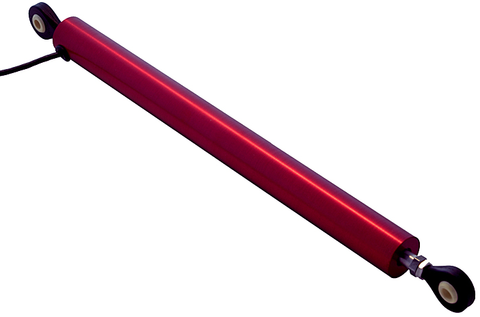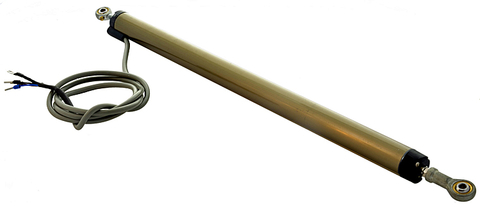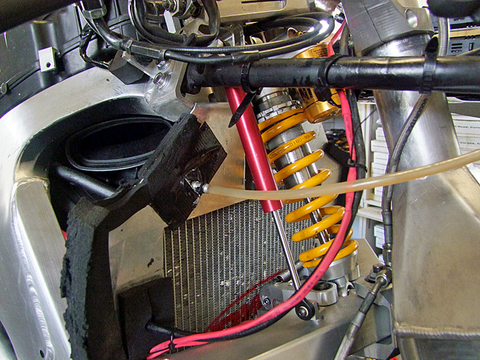
Linear position measurement is a frequent requirement for many industrial automation or process control systems, QA functions, and R&D testing. The actual position measurement function is normally done by some type of position sensor, the selection of which quite often is based on just a few key specification parameters and its purchase cost. However, using the sensor’s purchase cost for economic guidance can be very misleading.
The real cost of utilizing that sensor must be considered based on installation costs, operational costs over its required service period, maintenance and recalibration costs, operator training, and possible replacement cost. When taken together, these costs, along with several other expenses which will be identified later in this article, add up to the True Cost of Ownership (TCO).
This series of articles will help you to evaluate the TCO of commonly used linear position sensors. The first article identifies the most commonly utilized industrial position sensing technologies and poses a set of questions to ask yourself about various position sensor application issues to assist you to make an optimum choice of sensor from both a technical and an economic perspective.
The second article starts by examining the strengths and weaknesses of these technologies, presents a comparison chart of their specification parameters with a brief explanation of what those specifications mean, and helps to focus on the technical aspects involved in TCO evaluation. Last, the third article pulls together the answers about costs derived from the answers to the queries in the initial article, combines that information with the choices made because of the examination of sensor technologies and the weighting applied to the specifications parameters in the second article, and shows how these factors combine into the TCO.
The most commonly used industrial position sensing technologies incorporate a moving element which is attached to the object or workpiece whose position is being measured, while the body of the sensor is fixed in position. Typical of these are Linear Variable Differential Transformers (LVDTs), Linear Variable Inductance Transducers (LVITs), Magnetostrictive Linear Displacement Transducers, (MLDTs, also known as LDTs), and linear resistance potentiometers or pots. And while these sensors all operate on different physical principles, they are all analog output sensors.
There is another style of linear position sensor that has a digital output. They are glass scale encoders, but their use is largely limited to the machine tool and CMM markets primarily because they are not considered robust enough for most of industrial automation or mobile hydraulics applications.

Some position sensing technologies function without requiring any physical contact with the object whose position is being measured, and are often called “non-contacting” position sensors. Typical examples are proximity, ultrasonic, laser, radar, optical, and similar sensors. However, these types of sensors all have drawbacks that can limit their use, such as specific target materials required for proximity, environmental effects on ultrasonic, high initial cost as well as the eye protection requirement for lasers, etc.
For these reasons, non-contacting position sensing technologies will be excluded from the focus of this article.
Of the four common sensor technologies, the first three are contactless, that is, they do not require any physical or electrical contact between their moving element and their fixed part. Pots, however, do have a wiper that contacts an internal resistance element that is fundamental to their operation, so they are not contactless. The foregoing explanation should illustrate the difference in the meaning of contactless and non-contacting as applied to position sensors.

All four sensor technologies will be described in detail in the second article of this series. But before comparing the details of these common industrial position sensing technologies, there are many questions you should answer to assist you in choosing the optimum sensor for your application from among them.
Can you define explicitly what are you attempting to accomplish with the position measurement?
While this may seem to be an obvious step, it is often overlooked during a sensor selection process and is critical to developing an overall perspective. Once you answer this question, other questions pertaining to the details of the measurement can be posed.
What is the nature of your sensing application?
Typical answers include automation or control systems, industrial process monitoring without automatic control, product quality assurance, and R&D lab testing. Your response will help formulate the weighting of priorities that you should apply to the specification parameters of the sensors under consideration. For example, an automatic control system would likely require better dynamic response than a typical quality assurance test, but quality assurance measurements usually requires better measurement precision and especially calibration traceability.
In what environment is the sensor expected to operate and how harsh is it?
There are many issues involved in answering this question. One is the range of ambient temperatures in which the sensor will be expected to operate. Another is the level of vibration and/or shock which the sensor will experience. A key issue is the degree the sensor will be exposed to moisture, coolant mists, solvent or chemical vapors, and dust or grit. For example, in a typical factory floor environment, there can be serious shock impulses transmitted from the structures of punch presses and a large amount of grit that can accumulate from sanding or finishing operations.

Is there possible electromagnetic interference (EMI) from arc welders, variable frequency motor drives, or 2-way radios? Finally, is the sensor going to be operating in a hazardous location that would require a UL, FM, or CSA hazloc-approved component?
What reliability and quality issues apply to the position sensor?
Several important factors pertain to this topic, the most important of which is whether the sensor is being used in a safety-critical application where its failure could result in serious injury to personnel. In such an application, reliability becomes the highest priority in selecting the right position sensor technology. For less critical uses, the key quality questions relate to the measurement system’s duty cycle and expected service life. Reliability comes into sharp focus when the sensor must operate on a 24/7/365 duty cycle that can cause sensor system operating cycles to accumulate very quickly and wearout to develop in a relatively short period of time.
Another factor pertaining to reliability is the frequency of recalibration required for the position sensor, as well as its preventative maintenance program. Downtime of the position measuring system, whether it is scheduled or unscheduled, typically has a significant cost beyond the direct expenses of recalibration or maintenance. Replacing a worn out or failed sensor also can introduce downtime of substantial cost.
Are there any additional items needed to make the position sensor function?
Typical examples are ancillary electronics like power supplies, signal conditioners, and various cables. An often overlooked extra is the need for specific mounting hardware and the labor for installing the sensor. A further requirement could be special software that must be acquired to effectively utilize the sensor.
Is there any special training or a sensor- dependent learning curve for the measuring system operator?
This is usually the most common unanticipated issue in applying a sensor in a measuring system. If this is a potential expense, then it is necessary to consider it in developing a budget for the real installed cost of the position sensor in the measuring system.
What position measurement accuracy and resolution are actually required for your application?
It is quite possible for the position sensor in a measuring system to be over- specified in these regards, which can add unnecessary difficulty in making the choice of the optimum sensor from among the many technologies available and certainly can add cost. The key to this issue is a good understanding of what these parameters mean, which will be explained in the second article in this series. Then you should evaluate the effect of lower accuracy and/or resolution for the position measurement application by doing the necessary calculations. In performing these calculations, pay particular attention to the exact way the specification is presented. Unfortunately, it is possible for a sensor manufacturer to utilize specmanship that favors their product and can lead to misunderstanding unless the parameter is closely scrutinized.
The foregoing questions assist in the selection of the correct sensor so that a prospective position sensor user or specifier will gain insight into various factors. These factors go into the choice of a position sensor for a measurement application and can establish a weighted priority list of specification parameters for the optimum sensor choice that uses the information derived from the answers or responses to these questions. The next article in this series continues with a more detailed technical explanation of the strengths and weaknesses of the four technologies cited above, accompanied by a comparison chart of the significant specifications and parameters, along with a brief explanation of the meaning of these specifications. Then the third article delves into all the cost factors that make up the true installed cost of a position sensor and how you can assimilate the results into a TCO of the position measuring system.
About the author
Harold Schaevitz, the third generation in the sensor industry, started his career in 1981 at Schaevitz Engineering as an eastern regional sales manager. He founded Schaevitz Intertech in 1990 for contract manufacturing. In 2006 he founded HGSI The Sensor Connection marketing and distributing EGT sensors and linear positions sensors. In 2009 he founded Sensing Solutions, specializing in marketing American-made linear position, rotary, and tilt sensing products to the Far East.